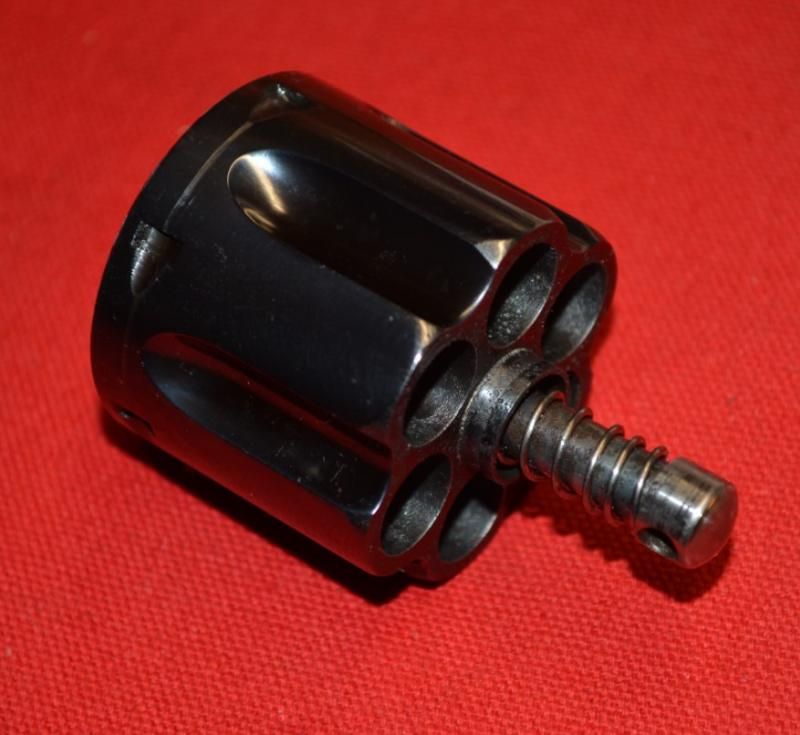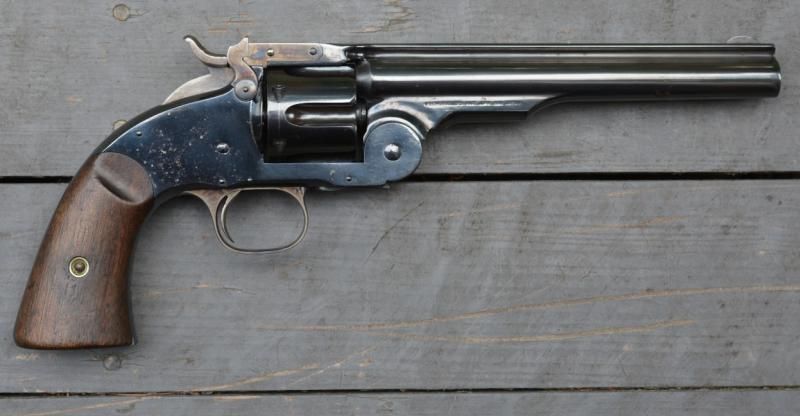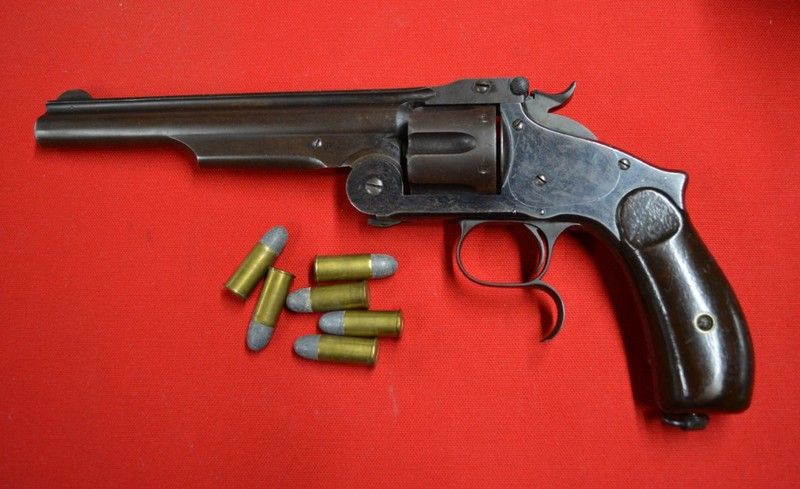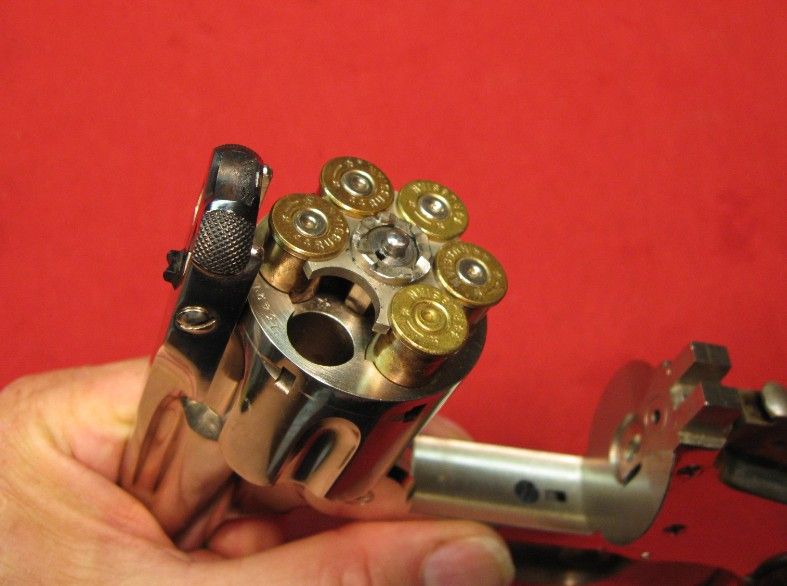Howdy
A couple of things.
Yes modern Top Break revolvers made by Uberti are very well made, quality firearms.
And yes, they do not do well firing Black Powder, but it has nothing to do with 'tight tolerances'. Nobody made revolvers with tighter tolerances than Smith and Wesson in the 19th Century, and their Top Break revolvers were particularly well suited for Black Powder. As Hawg suggested, the inability of modern Top Break revolvers made by Uberti to shoot Black Powder well is caused by a redesign of the firearm, not tight tolerances.
Like most revolver designs, the length of the cylinder of the original Smith and Wesson Top Break revolvers was dictated by the length of the cartridges they fired. The first cartridge developed for these revolvers was the 44 S&W American cartridge, which featured a heeled bullet. It was a relatively short cartridge, only about 1.320 long overall. So Smith and Wesson settled on a cylinder nominally 1 7/16" long to accommodate the 44 American Cartridge. When the Russian government signed a contract with S&W for a large order of revolvers around 1870, they stipulated the cartridge carry a more modern bullet with the lubrication applied to grease grooves on the side of the bullet that could be completely covered within the cartridge case when the bullet was seated. This resulted in the cartridge we know today as the 44 Russian cartridge. Overall length of some 44 Russian cartridges in my collection is about 1.435. This length still fits comfortably in a cylinder nominally 1 7/16" long.
Here is a photo of an original S&W 2nd Model Russian with six original 44 Russian cartridges.
Here is a close up view of the area of the barrel/cylinder gap and the gas bushing or collar on the Russian revolver.

Here is a view of the Russian cylinder. The gas collar is the part protruding out from the front face of the cylinder. It is a separate piece, pressed into the center of the cylinder. The gas collar measures approximately .180 long. So going back to look at the previous photo again, it can be seen that while the end of the barrel butts up against the front face of the cylinder (yes with a tiny gap) the gas collar extends about .180 forward of the barrel/cylinder gap. This is the secret of any successful Black Powder revolver design. Offset the barrel cylinder gap horizontally from the farthest forward portion of the cylinder where powder fouling blasted out of the gap might find its way down to the cylinder arbor or pin. This feature, by the way, was also present on the Colt Single Action Army in 1873, which contributed to its success dealing with Black Powder cartridges. Ruger and every other successful single action revolver designer has incorporated this feature, even today.

Here is a 1st Model S&W Schofield revolver. You can see that it too has a sizeable bushing pressed onto the front of the cylinder, performing the same job of shielding the underlying arbor from fouling blasted out of the barrel/cylinder gap. Incidentally, when S&W bid on an Army contract to provide the military with an alternative to the Single Action Army, it was Daniel Wesson's reluctance to retool for a longer cylinder that resulted in the cartridge we know today as the 45 Schofield cartridge. The Schofield model had the same 1 7/16" long cylinder as previous models, and it was too short to accommodate the 45 Colt cartridge. The Army insisted on a 45 caliber revolver, but relented on the length of the cartridge and contracted with S&W to buy about 8,000 45 caliber Schofield revolvers chambered for the shorter Schofield round.

OK, flash forward to the modern era. When Uberti and a few other Italian replica arms companies decided to build a replica of the S&W Top Break revolvers, they made a conscious decision to chamber them for the more readily available 45 Colt and 44-40 cartridges, not the shorter and less easily available 44 Russian or 45 Schofield cartridges. So what to do about the 1 7/16" long cylinder? Obviously make it longer for the longer cartridges. But they did not want to stretch the overall length of the revolver, so something had to give. It was the gas collar. The gas collar is still present on all modern replicas of the S&W Top Break revolvers, but it has been shortened so much that it is ineffective at shielding the underlying cylinder arbor from fouling blasted out of the barrel/cylinder gap. And that is why modern replicas of the S&W Top Breaks need frequent cleaning to prevent the cylinders from binding. The short cylinder bushing cannot do the job it was suppose to do.
On the other hand, I can shoot my original S&W Top Breaks all day long with Black Powder and they never bind up, because that is what they were designed to do.
I'd be using it for target use and possible defense out on the trail. I'd figure a top break .45 Colt would be good medicine for bandits and wild vermin. I hardly see anyone ever talking about them and was just wondering.
I would be hard pressed to come up with a worse candidate for self defense from two legged or four legged predators than the Russian model (the model in the photo the OP posted in his original question).
The reason is that big, sharp, pointed hump on the grip. This was part of the design requirements the Russians imposed on Smith and Wesson, along with the excellent 44 Russian cartridge and the silly spur on the bottom of the trigger guard. The intent of the hump, it is called a Knuckle in S&W land, was to prevent the revolver from rotating in the hand with recoil. It does an excellent job of this, the revolver does not rotate at all in recoil, unlike the Schofield Model or the Colt SAA with their curved grips. The problem comes from the fact that the reach to the hammer spur on all the S&W Top Breaks was further than the reach on a Colt. I have fairly large hands, even so I have to regrip the Russian model in order to be able to reach the hammer spur with my thumb for every shot. This puts the sharp, pointy knuckle of the grip in direct contact with the web between my thumb and first finger. In order to fire I have to regrip again to get my hand completely below the knuckle. In the heat of battle, when firing rapidly I may forget to regrip again to get my hand under the knuckle. If I do, the knuckle digs into the web of my hand with a vengeance, and even with a light recoiling round like 44 Russian, it smarts. To say nothing of what it does to the accuracy of my shot.
Yes, the modern reproductions of the S&W Top Breaks made by Uberti are quality firearms. While they do not have the frame strength of a solid frame revolver such as the SAA, I know at least one Cowboy Action Shooter who shoots a pair of Uberti Schofields at every match and has had no problems with the frame stretching or any of the other problems commonly associated with Top Break revolvers. But he is shooting light Cowboy loads. I suspect his revolvers would not stand the test of time with heavy loads.
Yes, all Top Break S&W replica revolvers are much quicker to reload than a SAA or other conventional single action design because ejection is automatic (pretty much) when you break the gun open all the way, and loading five (NOT SIX) rounds into the back of an open cylinder is much faster than loading one at a time through a loading gate.
Would I choose a Top Break as a hiking companion? Absolutely not. I have been shooting single action revolvers for a long time and I am very familiar with them. But I would choose a modern double action revolver with a swing out cylinder for a hiking companion where I might possibly run into an unfriendly two legged or four legged adversary. No predator is going to be impressed with how cool a Top Break revolver is.







